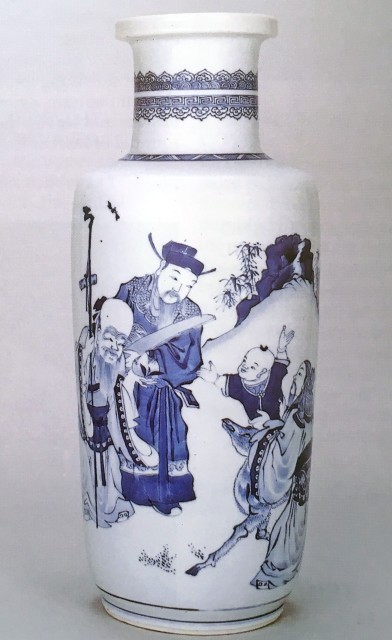The Eight Immortals presided over the great cave heavens of Daoist mythology situated in the Chinese mountains and stories abound concerning these mystic abodes. Their usual form of travel whilst in the celestial spheres was on clouds. Each represents a different condition in life, i.e., poverty, wealth, aristocracy, plebianism, age, youth, masculinity and femininity.
As decoration on porcelain they are frequently represented together with Shoulao the Star God of longevity. The eight Daoist emblems are the attributes of the immortals.
Shoulao, the God of Longevity, is depicted as gentle and smiling, with a exaggeratedly high forehead. He holds in one hand a staff and gourd and in the other the fruit of the fabulous tree, Pan Tao, which blossoms every three thousand years and only bears its peaches three thousand years later. He is usually represented riding a stag with a flying bat above his head, symbols of happiness; the peach and staff symbolise longevity.
1. Zhongli Quan, Zhou dynasty, 1122 249 B.C., chief of the Eight Immortals, who had the secret of the elixir of life and powers of transmutation, is depicted as a fat man sometimes holding a peach in his hand and always grasping his emblem, a fan, which is said to be capable of resuscitating the souls of the dead.
2. Zhang Guolao, 7th/8th century A.D., was a recluse who had supernatural powers of magic such as rendering himself invisible. He is usually depicted with a white mule which he rode backwards over great distances, and, when not required was folded away and put in his wallet. When he wished to resume his travels he squirted some water on the wallet and the mule at once appeared. His emblem is a You Gu, a kind of musical instrument in the shape of a bamboo tube or drum with two rods to beat it.
3. Li Dongbin, circa 750 A.D., a scholar or recluse, he learned the secrets of Daoism from Zhongli Quan. He is the patron saint of the barbers and is also worshipped by the sick and is able to rid the world of evils. His emblem is a sword which is used for dispelling evil spirits.
4. Cao Guo Qiu, 930 999 A.D., son of a military commander and brother of the Empress Cao of the Song Dynasty. He is patron saint of the theatrical profession. His emblem, the castanets, which symbolise revival, are said to be derived from the court tablet, authorising free access to the palace, to which he is entitled owing to his birth.
5. Li Tieguai is represented as a beggar leaning on an iron staff with a pilgrim's gourd. Due to his magic powers he spent much time in spirit the celestial regions, leaving his body, apparently dead, in charge of his disciple. Once when he was absent longer than usual, having to go and take care of his sick mother, his servant decided that his master was really dead this time and buried the body. When the soul of Li Tieguai returned, he found that he had no body into which to enter, so he entered into the body of the first good person he could find, a lame beggar. His emblem is a gourd which is said to contain all kinds of magical cures.
6. Han Xiangzi is credited with the power of making flowers grow and blossom instantaneously. His emblem is the flute and he is the patron saint of musicians. He wandered the country charming the birds and the beasts with his music. He had no idea of the value of money, and when given any he used to scatter it on the ground.
7. Lan Caihe, 700 - 800 A.D. Variously stated to have been a woman and a hermaphrodite. She is represented as dressed in a long gown, she wandered the country waving a wand and denouncing this fleeting life and its delusive pleasures. Her emblem is the flower‑basket which she carries, and she is the patron saint of the florists.
8. He Xiangu was the daughter of a 7th century A.D. shopkeeper of Lingling, Hunan. Having eaten the supernatural peach , she became a fairy. She wandered alone in the hills and lived on a diet of crushed mother of pearl and moonbeams. Her emblem is the lotus and she is sometimes portrayed as standing on a lotus petal holding a fly whisk in her hand.

